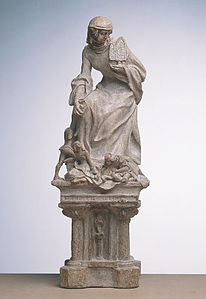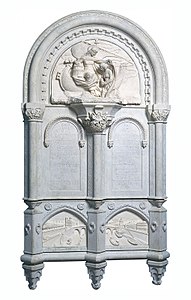Félicie de Fauveau
Félicie de Fauveau (born January 24, 1801 in Livorno , † December 12, 1886 in Florence ) was a French sculptor .
Life
Félicie de Fauveau was the eldest daughter of the Breton banker Alexandre de Fauveau, who had settled in Italy, and his wife Anne (nee de La Pierre). The couple had four children and returned to France in 1814. In 1824 she initially took drawing lessons from the painters Louis Hersent and Claude Guillot in Paris , but soon found more interest in sculptural design. Since women were denied an academy study at the École des Beaux-Arts , she learned sculpture on an autodidactic basis. During her self-study, she occasionally sought advice from painters and sculptors who were friends, including Paul Delaroche , Jean-Auguste-Dominique Ingres and Ary Scheffer . She sold one of her first works, Francesca da Rimini , to the Paris gallery Pourtalès. In 1829 de Fauveau took part in the Salon de Paris , where she showed her works L'Abbé and Christine et Monaldeschi , through which she finally became known in art circles.
In addition to her sculpting work, de Fauveau also made a name for herself as "Héroine de la Vendée" (heroine of the Vendée). Raised in the royalist tradition, she took an active part in the uprising in the Vendée against the republican troops as a supporter of the old Bourbon line . After her capture in 1832 and eight months of incarceration, she was able to flee to Belgium and from there returned to Italy in 1834, where she settled in Florence until the end of her life. In her studio she created works of which she showed the marble bas-relief Judith with the head of Holofernes at the Paris Salon in 1842 and the bronze relief Jarnac's battle with La Châtaignerie in 1852 . At the Paris World Exhibition in 1855 she presented the group The Martyrdom of St. Dorothea in front.
Félicie de Fauveau worked with different materials such as marble, wood, bronze, iron and steel. In addition to portraits, sculptures, reliefs and some fountains, she also created chased weapons and sword sticks, which she made in the troubadour style - a French variant of Neo-Gothic - in the style of historicism . Most of the works are privately owned, especially in England, Italy and Russia.
- Works by Félicie de Fauveau
Burial bust of a child (after 1833), Musée des Augustins de Toulouse
Model for a monument to Clémence Isaure (1845), Musée des Augustins de Toulouse
Monument to Antoine-Jean Gros (1847), Musée des Augustins de Toulouse
Tomb for Louise Favreau (1854), Santa Croce , Florence
Tomb for Anna de Fauveau (1859), Santa Maria del Carmine , Florence
Works (selection
- Francesca da Rimini
- L'Abbé , 1829, Musée municipal de Louviers (Louviers City Museum), Louviers
- Christina et Monaldeschi , 1829, Musée municipal de Louviers
- Relief on the monument of the painter Antoine Jean Gros and his wife Augustine Dufresne, 1837, Musée des Augustins, Toulouse
- Marble bas-relief Judith with the head of Holofernes , 1842
- Lady with Greyhound , 1846, Orangery Palace , Potsdam
- Monument to the painter Antoine Jean Gros with Saint Genoveva , 1847, in collaboration with her brother Hippolyte de Fauveau, Musée des Augustins
- Dante monument, 1847
- The fight between Jarnac and La Châtaignerie , 1852
- The Martyrdom of St. Dorothea , 1855
- Burial bust of a child, Musée des Augustins
- Dagger of the Russian Grand Duchess Maria Nikolayevna Romanova , Louvre , Paris
- Ring collar , made around 1830/32 for Marie Caroline de Bourbon-Deux Sicile, duchesse de Berry
- Tomb for Louise de Favreau , in Santa Croce Church , Florence
- Tomb for Harriet Webster Pellew (First Wife of the Admiral Hon. Fleetwood Broughton Reynolds Pellew), 1849, Cimitero degli Inglesi (so-called “English Cemetery”), Florence
- Tomb for Charles Lyon Herbert , 1855, Cimitero degli Inglesi
literature
- Fauveau, Félicie de . In: Ulrich Thieme (Hrsg.): General Lexicon of Fine Artists from Antiquity to the Present . Founded by Ulrich Thieme and Felix Becker . tape 11 : Erman-Fiorenzo . EA Seemann, Leipzig 1915, p. 304-305 ( Text Archive - Internet Archive ). - (gives Florence as place of birth and the year 1802).
- Isabella Blagden: Félicie de Fauveau In: English Women's Journal. 2, 1858, pp. 83-94 (English, florin.ms ).
- Antonius Lux (ed.): Great women of world history. A thousand biographies in words and pictures. Sebastian Lux Verlag, Munich 1963, p. 166.
- Delia Gaze, Maja Mihajlovic, Leanda Shrimpton (Eds.): Dictionary of Women Artists . tape 1 : Introductory surveys Artists, A-I . Fitzroy Dearborn Publishers, London / Chicago 1997, ISBN 1-884964-21-4 , pp. 511 ff . (English, books.google.de - reading sample, gives Florence as the place of birth and the year 1802).
- Anastasia Easterday: “Labeur, Honneur, Douleur”: Sculptors Julie Charpentier, Félicie de Fauveau, and Marie d'Orléans . In: Woman's Art Journal . tape 18 , no. 2 , 1997, ISSN 0270-7993 , p. 11-16 , doi : 10.2307 / 1358545 , JSTOR : 1358545 (English).
Web links
- Musée d'Orsay: Félicie Fauveau. The Amazon of Sculpture (multiple parts)
- Félicie de Fauveau (1801-1886), the Amazon of Sculpture. In: The Art Tribune.
Individual evidence
- ↑ a b Fonds Félicie de Fauveau (1834–1886). FranceArchives, accessed February 18, 2019 (French).
- ↑ artandarchitecture.org.uk
- ↑ farm2.static.flickr.com
| personal data | |
|---|---|
| SURNAME | Fauveau, Félicie de |
| BRIEF DESCRIPTION | French sculptress |
| DATE OF BIRTH | January 24, 1802 |
| PLACE OF BIRTH | Livorno |
| DATE OF DEATH | December 12, 1886 |
| Place of death | Florence |





